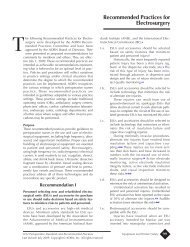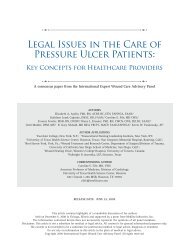71. Kelleher RE, Meeropol E, Parks D. Factors influencing the development of symptomatic bacteriuria in children on clean intermittent catheterization. J UrolNurs. 1996;15(2):1256-1265.72. Waites KB, Canupp KC, DeVivo MJ. Epidemiology <strong>and</strong> risk factors <strong>for</strong> urinary tract infection following spinal cord injury. Arch Phys Med Rehabil.1993;74(7):691-695.73. Anderson RU. Non-sterile intermittent catheterization with antibiotic prophylaxis in the acute spinal cord injured male patient. J Urol. 1980;124(3):392-394.74. Van Der Kooi, T. I. I., De Boer, A. S., Mannien J, et al. Incidence <strong>and</strong> risk factors of device-associated infections <strong>and</strong> associated mortality at the intensive carein the dutch surveillance system. Intensive Care Med. 2007;33(2):271-278.75. Bochicchio GV, Joshi M, Shih D, Bochicchio K, Tracy K, Scalea TM. Reclassification of urinary tract infections in critically III trauma patients: A time-dependentanalysis. Surg Infect. 2003;4(4):379-385.76. Leone M, Albanese J, Garnier F, et al. Risk factors of nosocomial catheter-associated urinary tract infection in a polyvalent intensive care unit. Intensive CareMed. 2003;29(7):1077-1080.77. Tissot E, Limat S, Cornette C, Capellier G. Risk factors <strong>for</strong> catheter-associated bacteriuria in a medical intensive care unit. Eur J Clin Microbiol Infect Dis.2001;20(4):260-262.78. Colau A, Lucet JC, Rufat P, Botto H, Benoit G, Jardin A. Incidence <strong>and</strong> risk factors of bacteriuria after transurethral resection of the prostate. Eur Urol.2001;39(3):272-276.79. Ousl<strong>and</strong>er JG, Greengold B, Chen S. Complications of chronic indwelling urinary catheters among male nursing home patients: A prospective study. J Urol.1987;138(5):1191-1195.80. Hazelett SE, Tsai M, Gareri M, Allen K. The association between indwelling urinary catheter use in the elderly <strong>and</strong> urinary tract infection in acute care. BMCgeriatr. 2006;6:15.81. Saint S, Kaufman SR, Rogers MAM, Bakers PD, Boyko EJ, Lipsky BA. Risk factors <strong>for</strong> nosocomial urinary tract-related bacteremia: A case-control study. Am JInfect <strong>Control</strong>. 2006;34(7):401-407.82. Srinivasan A, Karchmer T, Richards A, Song X, Perl TM. A prospective trial of a novel, silicone-based, silver-coated foley catheter <strong>for</strong> the prevention ofnosocomial urinary tract infections. Infect <strong>Control</strong> Hosp Epidemiol. 2006;27(1):38-43.83. Cardosi RJ, Cardosi RP, Grendys EC,Jr., Fiorica JV, Hoffman MS. Infectious urinary tract morbidity with prolonged bladder catheterization after radicalhysterectomy... includes discussion. Obstet Gynecol. 2003;189(2):380-384.84. Johansson I, Athlin E, Frykholm L, Bolinder H, Larsson G. Intermittent versus indwelling catheters <strong>for</strong> older patients with hip fractures. J Clin Nurs.2002;11(5):651-656.54
85. Hustinx WN, Mintjes-de Groot, Verkooyen RP, Verbrugh HA. Impact of concurrent antimicrobial therapy on catheter-associated urinary tract infection.[seecomment]. J Hosp Infect. 1991;18(1):45-56.86. Johnson JR, Roberts PL, Olsen RJ, Moyer KA, Stamm WE. <strong>Prevention</strong> of catheter-associated urinary tract infection with a silver oxide-coated urinary catheter:Clinical <strong>and</strong> microbiologic correlates. J Infect Dis. 1990;162(5):1145-1150.87. Lima NL, Guerrant RL, Kaiser DL, Germanson T, Farr BM. A retrospective cohort study of nosocomial diarrhea as a risk factor <strong>for</strong> nosocomial infection. J InfectDis. 1990;161(5):948-952.88. Jacono JJ, Talamelli CL. Nosocomial urinary tract infection in catheterized patients. Infect <strong>Control</strong> Can. 1988;3(1):16-20.89. Lanara V, Plati C, Paniara O, et al. The prevalence of urinary tract infection in patients related to type of drainage bag. Sc<strong>and</strong> J Caring Sci. 1988;2(4):163-170.90. Holliman R, Seal DV, Archer H, Doman S. <strong>Control</strong>led trial of chemical disinfection of urinary drainage bags. reduction in hospital-acquired catheter-associatedinfection. Br J Urol. 1987;60(5):419-422.91. Mulhall AB, Chapman RG, Crow RA. Bacteriuria during indwelling urethral catheterization. J Hosp Infect. 1988;11(3):253-262.92. Pien FD, L<strong>and</strong>ers JQ,Jr. Indwelling urinary catheter infections in small community hospital. role of urinary drainage bag. Urology. 1983;22(3):255-258.93. Shapiro M, Simchen E, Izraeli S, Sacks TG. A multivariate analysis of risk factors <strong>for</strong> acquiring bacteriuria in patients with indwelling urinary catheters <strong>for</strong> longerthan 24 hours. Infect <strong>Control</strong>. 1984;5(11):525-532.94. Platt R, Polk BF, Murdock B, Rosner B. Risk factors <strong>for</strong> nosocomial urinary tract infection. Am J Epidemiol. 1986;124(6):977-985.95. Burke JP, Larsen RA, Stevens LE. Nosocomial bacteriuria: Estimating the potential <strong>for</strong> prevention by closed sterile urinary drainage. Infect <strong>Control</strong>.1986;7(2):96-99.96. Saramma PP. Catheter-associated urinary tract infection: A follow-up study in prevention. Nurs J India. 1987;78(10):257-259.97. Islam AK, Chapman J. Closed catheter drainage <strong>and</strong> urinary infection--a comparison of two methods of catheter drainage. Br J Urol. 1977;49(3):215-220.98. Hartstein AI, Garber SB, Ward TT, Jones SR, Morthl<strong>and</strong> VH. Nosocomial urinary tract infection: A prospective evaluation of 108 catheterized patients. Infect<strong>Control</strong>. 1981;2(5):380-386.99. Garibaldi RA, Burke JP, Britt MR, Miller MA, Smith CB. Meatal colonization <strong>and</strong> catheter-associated bacteriuria. N Engl J Med. 1980;303(6):316-318.100. Garibaldi RA, Burke JP, Dickman ML, Smith CB. Factors predisposing to bacteriuria during indwelling urethral catheterization. N Engl J Med.1974;291(5):215-219.55
- Page 4 and 5: AcknowledgementHICPAC thanks the fo
- Page 6 and 7: AbbreviationsADLAPACHE IIASAASBBUNC
- Page 8 and 9: I. Executive SummaryThis guideline
- Page 10 and 11: II. Summary of RecommendationsTable
- Page 12 and 13: II. Proper Techniques for Urinary C
- Page 14 and 15: 1. If obstruction is anticipated, c
- Page 16 and 17: a. Procedure-specific guidelines fo
- Page 18 and 19: III. Implementation and AuditPriori
- Page 20 and 21: IV. Recommendations for Further Res
- Page 22 and 23: V. BackgroundUrinary tract infectio
- Page 24 and 25: acteriuria inevitably occurs over t
- Page 26 and 27: VII. MethodsThis guideline was base
- Page 28 and 29: Figure 2: Results of the Study Sele
- Page 30 and 31: After determining the GRADE of the
- Page 32 and 33: Category I recommendations are defi
- Page 34 and 35: VIII. Evidence ReviewQ1. Who should
- Page 36 and 37: Evidence Review Table 1B. What are
- Page 38 and 39: Very low-quality evidence suggested
- Page 40 and 41: Q2B.2. Hydrophilic catheters vs. st
- Page 42 and 43: For all comparisons, we considered
- Page 44 and 45: a. Clamping vs. free drainage prior
- Page 46 and 47: studies. 3,25,260-276 The findings
- Page 48 and 49: 2D.5. Maintain unobstructed urine f
- Page 50 and 51: 15. Jain P, Parada JP, David A, Smi
- Page 52 and 53: 44. Chaudhuri P, Vengadasalam D. Ur
- Page 56 and 57: 101. Hirsh DD, Fainstein V, Musher
- Page 58 and 59: 132. Van Nagell, JR, Penny RM, Rodd
- Page 60 and 61: 163. Lai KK, Fontecchio SA, Lai KK,
- Page 62 and 63: 193. Waites KB, Canupp KC, Armstron
- Page 64 and 65: 222. Cohen A. A microbiological com
- Page 66 and 67: 253. Chavigny KH. The use of polymi
















